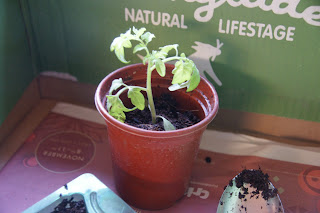Pottering On and Potting On
If, like me,
you don’t currently have a usable greenhouse, you might find yourself potting
up seedlings on the kitchen counter instead. Also like me, you might not enjoy the
prospect of getting compost everywhere – and using a sheet or two of newspaper doesn't always seem to help. Somehow that compost finds its way off the edge of
the paper and onto your floor, or counter top, or anywhere else it chooses. So what
to do?
I came up
with a simple solution that anyone can use. My dog food arrives in bulk, packed
neatly in small boxes, so I frequently have a small box or two lying around
waiting for recycling. I decided to use one of these to create a makeshift
potting bench, with sides. I simply cut down the front and covered the bottom
of the box with newspaper to avoid compost escaping through the cardboard flaps
at the bottom of the box – and voila! A usable box that keeps the compost in
one place.
PICTURE OF
POTTING BENCH
Amongst the
many pots and trays I seem to have collected, I have one that holds 18 pots
securely in a shaped tray. That is the exact number of small plants I bought
yesterday. Due to my tomatoes, chillis and peppers deciding not to germinate, I
bit the bullet and bought some seedlings – 3 moneymaker tomatoes; 3 gardeners’
delight tomatoes; six hot chillis; and 6 capsicum or sweet peppers. The pots
they arrived in are tiny, so the really needed potting up
as quickly as possible.
The job didn’t
take too long and was quite simple, but for those who have not moved a seedling
from one pot to another before, perhaps a bit of explanation wouldn’t go amiss.
For those of you who are old hands at this, then please feel free to ignore the
rest J
First off,
you have to decide what size of pot you are going to move the seedling into. I could
have moved mine straight into the pots that they will finish their growing in,
but decided in the end that moving them to an intermediate size would be better,
as they would then get ‘fed’ twice – once now and then again when I move them
to their final pots. The nutrients in compost only last so long and can be
washed out when you water the plants, so intermediate it is.
Put a couple
of handfuls of fresh compost in the bottom of the pot. To ensure the plant is
not planted too deeply (it should only be as deep in the compost as it is in
the original pot, otherwise your plant might rot), you can take the seedling,
still in its current pot and place this in the new pot to check for depth etc.
Once you are
satisfied that the seedling will be at the right depth, remove it carefully
from the old pot. The best way is usually to put a finger either side of the
plant, then tip the pot upside down. If the plant+compost doesn't slip out
immediately, give the sides of the pot a little squeeze, which should loosen
it. In the case of the these seedlings, they have been planted up in threes, so tipping them upside down is not an option. Instead, remove them with a good amount of compost still attached to the root, using a small indoor trowel or, if you don't have one, use a normal tablespoon from the kitchen. The point is that you do not handle the seedlings by their delicate stems as these can be easily damaged.
Place the
plant+compost from the old pot into the new pot and fill round the edges with
more fresh compost. Firm it gently and keep topping up with compost until the
old plant and the new compost are level. Water thoroughly, and if the compost
sinks a little, add a bit more to top it up. Multiply by 18. Don't forget to label your plants in their pots. Job done!
[Apologies for the poor quality of the last photo - I will try to take a better one tomorrow].
(Don't forget to check out my forum too: http://homegrown.forumotion.co.uk/. If people don't post then the community won't grow)








No comments:
Post a Comment